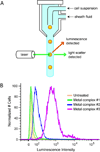Exploring the cellular accumulation of metal complexes
- PMID: 20104335
- PMCID: PMC2873847
- DOI: 10.1039/b922209j
Exploring the cellular accumulation of metal complexes
Abstract
Transition metal complexes offer great potential as diagnostic and therapeutic agents, and a growing number of biological applications have been explored. To be effective, these complexes must reach their intended target inside the cell. Here we review the cellular accumulation of metal complexes, including their uptake, localization, and efflux. Metal complexes are taken up inside cells through various mechanisms, including passive diffusion and entry through organic and metal transporters. Emphasis is placed on the methods used to examine cellular accumulation, to identify the mechanism(s) of uptake, and to monitor possible efflux. Conjugation strategies that have been employed to improve the cellular uptake characteristics of metal complexes are also described.
Figures




References
Publication types
MeSH terms
Substances
Grants and funding
LinkOut - more resources
Full Text Sources
Other Literature Sources

